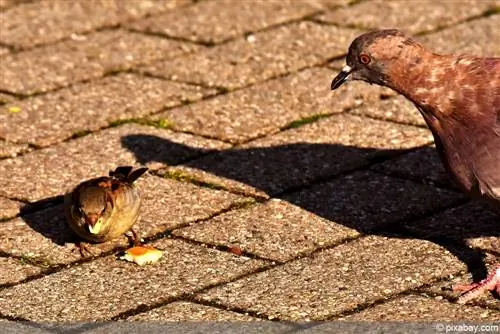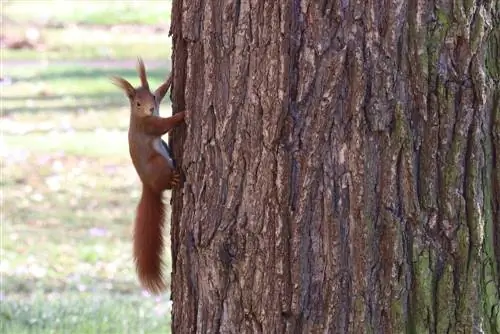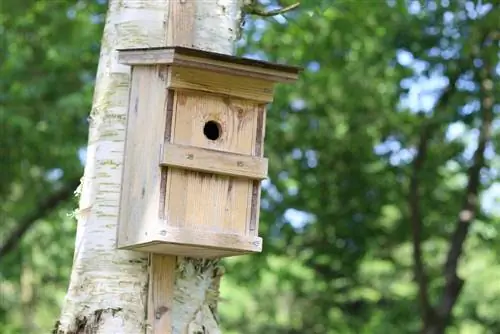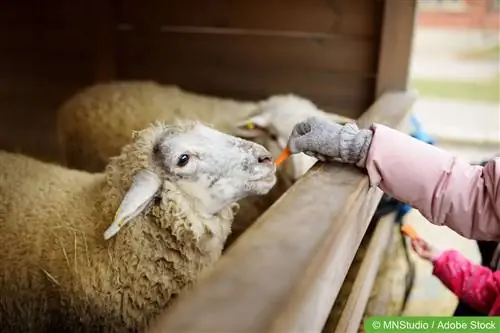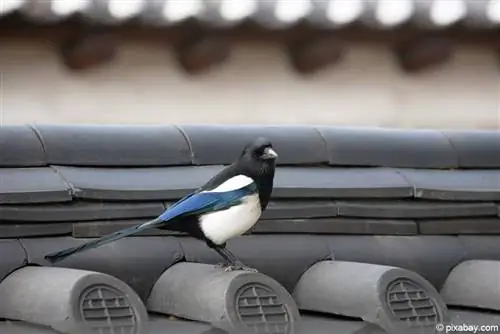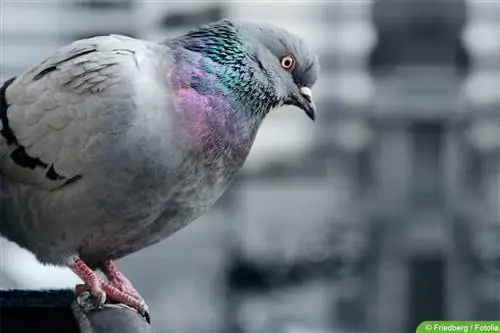- Author admin [email protected].
- Public 2023-12-17 03:39.
- Last modified 2025-01-24 12:45.
Animal-loving people, old people and small children just love feeding birds. Throwing a bit of bread to the ducks in the park, giving the birds in the garden hard edges of bread - this is considered a survival aid, especially in winter. However, this is not good for the birds, and in the park for different reasons than in the garden.
Birds don't choke on bread
Every now and then you hear that ducks and other birds would choke on the hard pieces of bread because they cannot chop them into small pieces with their beaks. With really hard pieces of bread it may be really difficult for the animals, but they don't put anything in their beaks that they can't swallow. So you definitely won't suffocate.
This especially applies to ducks and other waterfowl. If their food is too hard for them, simply dip it in the water until it is soft enough to eat. Nevertheless, in many communities it is forbidden to feed the birds in the park: the animals find a rich natural supply of food and can fend for themselves. If they are also fed with toast or other baked goods, the remains of the baked goods accumulate in the water and cause it to tip over at some point. And secondly, the animals are not naturally used to such carbohydrate-rich food; over time they would become obese. This is also undesirable, which is why a municipal feeding ban should definitely be observed.
The s alt is problematic
Many birds are grateful for a feeding place in the garden and like to be pampered, especially in winter. They like fruits, grains, cereals and seeds enclosed in fat. What they eat even though it's not good for them: bread. There is actually no s alt-free bread baked in Germany anymore. S alt is just as harmful to animals as pure fats (butter, lard or margarine) and pure white flour products. The animals need the fatty acids, vitamins and minerals that grain feed has, not least thanks to the shells and husks it contains. A piece of toast offers quick energy, but it also contains a lot of s alt and actually only short-chain carbohydrates that are quickly converted. That's not good for the animals. Also bad for the birds are:
- S alt sticks
- Chips
- Pretzels
- Sausage
- Ham
- Bacon
- Cheese
- frozen food
And there is another reason besides the s alt not to feed bread to the birds. The bread is dry and swells in the birds' stomachs, where it deprives the animals of moisture. Since the stomach is already full with the swollen bread, the bird will not drink - this is harmful to the he alth of the animals.
The right food for every type of bird
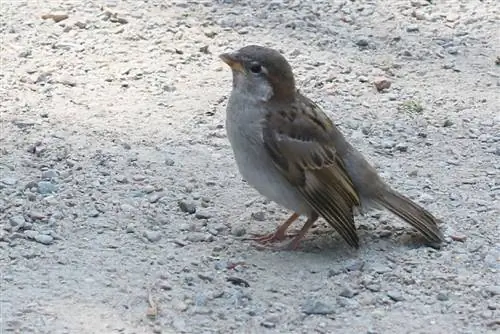
The different birds native to Germany eat very different things. While blackbirds like to get worms, maggots and small insects out of the ground in summer, they also like to eat grain food in winter. This applies to tits as well. And where the starlings do not fly south in autumn, they also eat grains in winter. Normal bird food or chicken food is well suited for winter feeding. The animals enjoy eating the bran that is used in the mixtures for chickens just as much as:
- Millet
- Rice
- Wheat
- Barley
- Corn
You can attract titmice with sunflower seeds. And they especially like it when the kernels are stuck together in a dumpling or a ring of suet. In addition to sunflower seeds, ready-made suet balls from specialist retailers often contain other seeds and grains, sometimes even nuts. The animals eat that too. Finches and sparrows often share the grain bowl with the tits, because these animals also like to eat grains and seeds.
Soft food for everyone else
Robins, dunnocks, blackbirds and other birds also overwinter in Germany. But they don't like to eat hard grains. These birds can be attracted with raisins, oatmeal, sliced apple pieces and citrus fruits. These birds also accept bran. They should not receive bread, for the reasons already mentioned above.
If fresh fruit is fed, it is important to ensure that it does not freeze. When temperatures drop below freezing point, the high water content in fresh fruit causes ice crystals to form. Such food is bad for the birds. If it is this cold, the food should really only be brought outside when the birds are eating (usually early morning and evening). Only a small amount of food should be placed outside so that the birds can eat the fruit immediately.
Set up feeding station safely
Food bowls on the floor attract rats. This scares the birds and leads to hygiene problems. In addition, birds do not like to eat on the ground, where they are easy prey for cats. The place for winter feeding should therefore be selected carefully. Spreading branches on trees that are not too high are ideal for placing food on them. But special feeders and feeders can also be hung in the trees; the birds usually like to accept these feeding places. Stand-alone birdhouses, on the other hand, should be constructed in such a way that they offer protection from both cats and birds of prey and cannot be climbed by mice or rats.
The feeding area should be kept clean. If the food gets wet, it will eventually mold and rot. This is extremely unhe althy for the birds and should therefore be avoided. A rain cover or a food container that is waterproof from the top and sides makes sense. If the lining still gets wet, it needs to be replaced.
Troughs and birdbaths are also important in winter
Grain food in particular is very dry. The birds therefore need some water to maintain their fluid balance. Birds also like to bathe in winter. A shallow clay bowl with some (warmed) water that is filled several times a day is a good idea. The birds cannot do anything with a frozen water source, so the bird bath should definitely be kept ice-free. It is usually enough to put the bowl of lukewarm water out in the morning when the temperatures are already above freezing, and bring the bowl back into the house in the afternoon before the lower temperatures at night cause the water to freeze.
Conflicting opinions on winter feeding
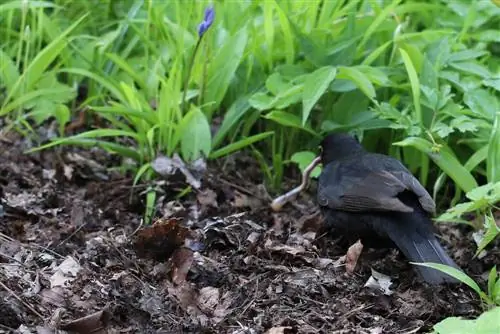
In general, winter feeding is not recommended, but there are still loud voices that speak out against it. Winter feeding does not help any endangered songbird species, and it will save few animals from starvation. The bird species that overwinter in Germany usually find enough food here. And the songbirds that actually migrate to the south and are hunted there only do not stay in Germany because of winter feeding (which could possibly save their lives and stabilize the populations). For animal welfare reasons or even to save species, feeding is not necessary.
But it doesn't do any harm either. The 20 or so bird species in Germany that are targeted by the rich food supply do not reproduce more simply because they are provided with food in winter. And they don't displace other species or anything like that. The animals don't get too lazy to look for their own food (because from a bird's point of view, feeding in the garden is simply too unreliable for that), so that the natural balance is not disturbed by the well-intentioned gifts.
But there is an important reason for having a feeding station in the garden or on the balcony: environmental education. Children who can observe animals at feeding stations develop a completely different understanding of these creatures and show them respect. Once interest has been aroused, the connections between habitats and native animal species are perceived and understood in a completely different way. Apart from that, it's of course just fun to watch the feathered and sometimes quite colorful aerial acrobats having their meal. Sparrows in particular perform wonderful tricks when they want to assert themselves against the competition at the feeding place!
And this attracts more unusual guests to the garden:
- Mealworms (for blackbirds and goldfinches)
- whole hazelnuts and acorns (for the jay)
- whole peanuts and corn kernels (magpie, jay, goldfinch)
- chopped nuts, poppy and hemp seeds (greenfinch)
- greased peanuts (for the green woodpecker)
It is very attractive when some types of food hang from high branches on a longer cord. Because woodpeckers, various grain eaters and even sometimes tits can run upside down down the thin ropes to get the food.
Better to only feed in winter
For environmental reasons, one might argue that feeding them all year round wouldn't do any harm. This is true so far, but there is a catch: when temperatures rise, it becomes more difficult to keep the feeding areas hygienically clean. The birds can infect each other very quickly with all sorts of diseases, and the food cannot be kept clean on warm, humid days.

